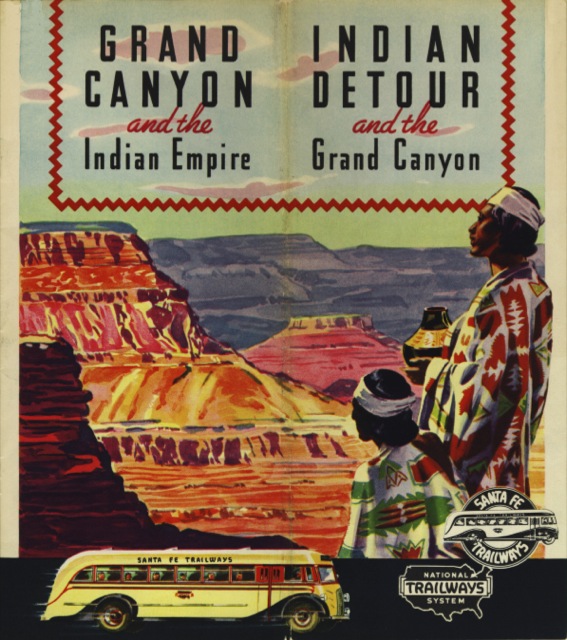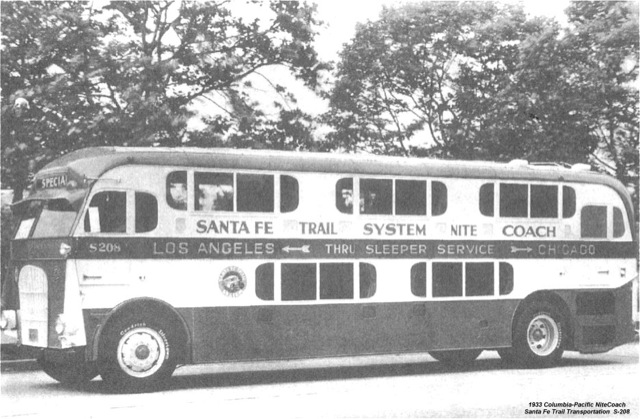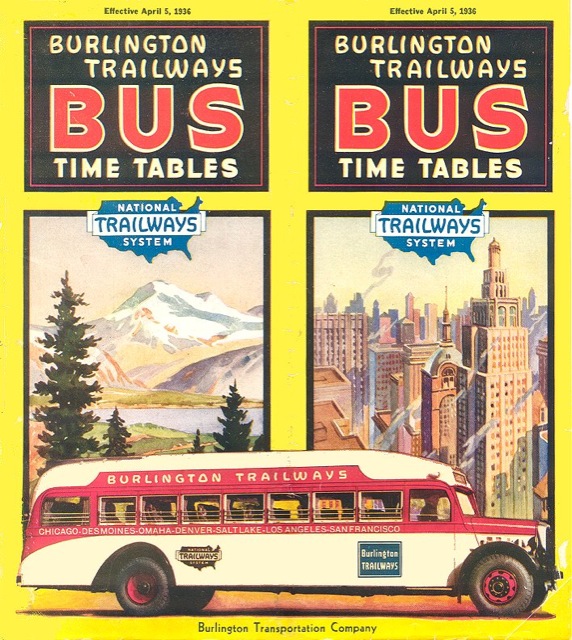While Greyhound was one company that had an interest in, and eventually absorbed, a number of other companies operating under the Greyhound name, Trailways was never more than a loose association of separate companies that attempted to coordinate their schedules and operations. Two railroads, Burlington and Santa Fe, formed the nucleus of Trailways, and they persuaded three other bus companies to join the original consortium.
 This brochure is not from my collection but can be downloaded, along with several other Santa Fe brochures, from the University of Arizona library web site–or click the image to download a 3.0-MB PDF of this 20-page brochure.
This brochure is not from my collection but can be downloaded, along with several other Santa Fe brochures, from the University of Arizona library web site–or click the image to download a 3.0-MB PDF of this 20-page brochure.
The Santa Fe Railway started Santa Fe Trail Transportation in 1928, and soon made it into a transcontinental company similar to Union Pacific Stages. A map inside the above brochure shows lines from Milwaukee, Chicago, and Little Rock in the East to San Francisco, Los Angeles, and San Diego in the West. Some routes, such as Flagstaff to Salt Lake City, didn’t follow the route of existing Santa Fe (or, in this case, any other) rails.

For a time, Santa Fe Trails operated these 1933 “nite coaches,” which had berths for 26 passengers, a kitchen, lavatory, and crew of three, from Chicago to Los Angeles. Click image for a larger view.
The Burlington Railroad started Burlington Transportation Company in 1929 to operate buses throughout its region. By 1935, Burlington was running buses to California as well.
 This is probably the first Burlington Trailways timetable produced. I don’t have the entire timetable, but you can click the image for a slightly larger view.
This is probably the first Burlington Trailways timetable produced. I don’t have the entire timetable, but you can click the image for a slightly larger view.
Two things happened in the 1930s that led to the formation of Trailways. First, Greyhound rapidly grew into a national carrier in which Great Northern’s substantial stake was joined by investments by Pennsylvania, Southern Pacific, and other railroads. Second, Congress passed the Motor Carrier Act of 1935, which gave the Interstate Commerce Commission the power to regulate bus companies and limited the ability of railroads to expand their bus subsidiaries.
With expansion impeded and a growing competitor, Santa Fe and Burlington agreed to operate their bus subsidiaries as a cooperating system. The name “Trailways” is probably partly derived from “Santa Fe Trails,” which in turn is derived from the old Santa Fe Trail along which the Santa Fe supposedly laid its rails.
Missouri Pacific joined its bus company to Trailways along with two non-railroad bus companies, Martz and Safeway. These five were almost immediately joined by Rio Grande’s bus subsidiaries, and eventually the consortium consisted of nearly 100 companies all operating under the Trailways banner. Other railroads whose bus lines were eventually a part of the Trailways system included the Boston & Maine, Reading, and Frisco.

This Burlington Trailways bus is a Brill IC-41, meaning Inter City 41-passenger bus, made immediately after World War II. Note that it has a destination of Los Angeles, well outside of the Burlington Railroad’s operating area. Click image for a larger view.
In 1948, Burlington, Santa Fe, and Rio Grande all sold their bus operations to Continental Trailways (no doubt getting at least partly paid with stock in the company). In the same year, Missouri Pacific strangely withdrew from Trailways, but later sold its bus operations to Midwest Bus Lines which was a Trailways company. Although Continental was probably the largest Trailways operator, there were still plenty of other Trailways companies that were independent of it.
Intercity bus ridership peaked in about 1960, and the railroads no doubt soon dumped any remaining stock ownership they had in Greyhound or Continental Trailways. Greyhound diversified into other areas, notably Dial Soap, then spun off the transportation company to private investors in 1987, one of whom had been an executive of Continental Trailways. The new Greyhound then purchased Continental Trailways, leaving many of the remaining Trailways operators without connections, and many either went out of business or focused on charters and tours. While one of those operators is called Burlington Trailways, it has no relation, other than the name, to the railroad-related company.
